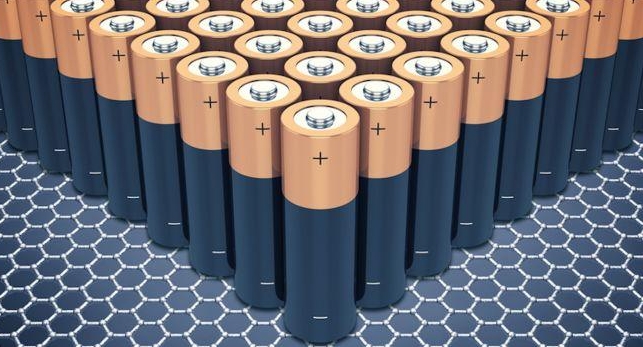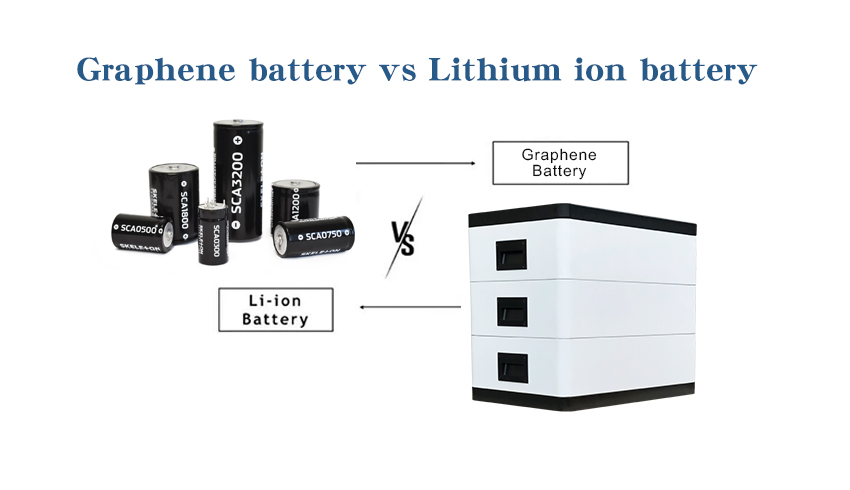随着对高效和可持续能源解决方案的需求不断增长, 石墨烯电池和锂电池已成为两个备受期待的竞争对手.
然而, 哪一个更适合您的需求?
您是否正在寻找适合电动汽车的电源, 智能手机, 或可再生能源系统, 本指南将深入研究他们的核心优势, 限制, 以及未来的发展前景,以帮助您做出明智的选择.
什么是石墨烯电池?

石墨烯电池的组成
石墨烯电池是一种使用石墨烯作为关键材料的储能设备.
石墨烯 是一种由蜂窝晶格结构中排列的碳原子组成的单层材料, 这引起了极大的关注,因为其出色的电导率和机械强度.
在石墨烯电池中, 石墨烯通常用作电极材料, 与电解质和另一种互补材料一起形成了电池的基本结构.
石墨烯电池已成为传统电池技术的理想替代品,因为它们的优势很高, 主要反映在以下方面:
快速充电能力:
石墨烯电池具有出色的充电验收性能,可以实现快速充电.
此功能在需要快速能源补充的电动汽车和便携式电子设备等应用中尤其重要.
高能量密度:
石墨烯电池的能量密度远高于传统锂电池的能量密度, 这意味着石墨烯电池可以在相同的质量和音量中存储更多的能量.
这不仅延长了设备的电池寿命, 但也提高了整体效率.
使用寿命长:
石墨烯的高耐用性和降解性大大延长了电池的使用寿命.
寿命更长意味着较低的电池更换频率, 从长远来看,这是一个更具成本效益的解决方案.
安全性更高:
石墨烯电池的稳定性较高,并且易于热失控.
热逃亡是传统锂电池中火或爆炸的主要原因, 石墨烯电池的优势使它们在电动汽车和储能系统等应用中更安全.
环境友善:
作为碳基材料, 石墨烯在电池中的应用有助于促进环境的可持续发展.
与依靠有毒元素的传统电池相比, 石墨烯电池是一种更干净,更环保的选择.
什么是锂电池?
锂电池是可充电的储能设备, 其阳性和/或负电极主要由锂化合物组成.
它的工作原理基于锂离子在充电过程中正和负电极之间的来回移动.
锂离子电池 (锂离子) 是锂电池最常见的类型, 广泛用于便携式电子设备, 电动汽车, 和可再生能源存储系统.
锂电池由于其许多优势而受到高度青睐:
高能量密度:
锂电池以其高能量密度和在紧凑型体积中存储大量能量的能力而闻名.
此功能使其成为需要极高尺寸和重量的应用程序的理想选择, 例如智能手机和笔记本电脑.
循环寿命长:
锂电池的充电周期寿命很长,即使多次用途也可以保持高容量.
这意味着他们可以保持较长时间的性能, 从而降低替换频率.
轻量化设计:
与许多其他电池相比, 锂电池重量更轻, 这为其在便携式设备中的应用提供了很大的优势.
轻巧的设计增强了设备的可移植性和用户体验.
高放电率:
锂电池可以快速输出高电流, 这对于需要瞬时高功率的应用至关重要, 例如电动汽车, 电动工具, 和高性能设备.
成熟的技术:
锂电池进行了广泛的研发, 他们的技术已经变得非常成熟.
它的大规模应用带来了成本效益, 使锂电池更实惠和受欢迎.
石墨烯电池与锂离子电池
石墨烯电池与锂离子电池之间的比较可以从多个方面进行, 以下是对两者的全面比较:
1. 能量密度
石墨烯电池:
它具有更高的能量密度, 从理论上讲,锂电池几倍.
例如, 石墨烯电池的特定能量可以到达 600 瓦时/公斤, 比 180 WH/kg锂电池.
锂电池:
能量密度相对较低, 但是它已被广泛用于电动汽车和便携式设备.
2. 充电速度
石墨烯电池:
快速充电速度, 可以在短时间内完成充电.
例如, 只需将3000mAh石墨烯电池充电到近一半的容量 5 分钟.
锂电池:
充电速度相对较慢, 特别是在低温环境中, 充电效率将进一步降低.
3. 循环寿命
石墨烯电池:
循环寿命长, 寿命 2-3 锂电池的时间.
锂电池:
循环寿命更长, 但不像石墨烯电池那样耐用.
4. 安全
石墨烯电池:
它具有更高的安全性, 更好的热稳定性, 而且不太容易失去热失控.
锂电池:
有一定的安全危害, 特别是在高温或过度充电条件下, 可能发生热失控的地方.
5. 成本
石墨烯电池:
现在, 高生产成本限制了其大规模商业应用.
锂电池:
低成本和成熟的生产技术目前是主流电池的选择.
6. 应用程序字段
石墨烯电池:
适合需要高性能的方案, 电池寿命长, 和快速充电, 例如高端电子设备, 航天, 和军事领域.
锂电池:
广泛用于电动汽车, 便携式电子设备, 和太阳能存储系统.
7. 环境友善
石墨烯电池:
更环保, 在准备过程中污染较少, 并可回收.
锂电池:
相对环保, 但是存在有限和不均匀分布的锂资源的问题.
概括
石墨烯电池在能量密度上具有显着优势, 充电速度, 循环寿命, 和安全, 但是成本很高,技术还没有完全成熟.
由于其成熟技术和较低的成本,锂电池已成为主流电池的选择. 将来, 随着石墨烯制备技术和降低成本的发展, 石墨烯电池预计将被广泛应用于更多的字段.
| 特征 | 石墨烯电池 | 锂电池 |
| 能量密度 | 更高, 每卷存储更多的能量 | 较低但改善 |
| 充电速度 | 非常快 | 缓和 |
| 循环寿命 | 由于耐用性,寿命更长 | 漫长但容易退化 |
| 安全 | 更高的安全性, 低热失控风险 | 改进, 但是仍然有一些风险 |
| 成本 | 昂贵的, 早期技术 | 更实惠和建立 |
| 应用领域 | 高性能电子产品, 高端电子设备, 航空航天和军事场 | 广泛用于电子和电动汽车 |
结论

随着科技的不断进步, 预计研究人员将在石墨烯和锂电池领域取得更多突破.
这些进步将进一步提高电池的性能, 降低成本, 并增强其可扩展性.
将来, 石墨烯和锂电池之间的竞争将继续推动储能技术的发展, 为不断增长的电力需求提供更有效和可持续的解决方案.
常见问题和答案
为什么我们还没有广泛采用石墨烯电池?
一方面, 石墨烯电池的大规模生产面临许多挑战, 原材料的可用性有限和基础设施不完整.
这些因素集体限制了石墨烯电池的促销和应用.
石墨烯电池的缺点是什么?
石墨烯电池的缺点主要反映在三个方面:
首先, 高成本限制了其大规模申请; 第二, 批量生产很困难,需要提高生产效率; 第三个挑战是可伸缩性, 这使得很难快速满足市场需求.
石墨烯希望未来电池?
石墨烯, 具有出色的电导率和轻巧的特性, 作为未来的电池技术表现出巨大的潜力.
石墨烯比锂更昂贵?
石墨烯的生产和加工过程相对复杂, 这可能会导致比锂更高的成本.
石墨烯可以取代电池中的锂?
石墨烯可以用作某些特定应用中锂的补充或替代材料.
然而, 在所有类型的电池技术中,不可能完全替换锂.
